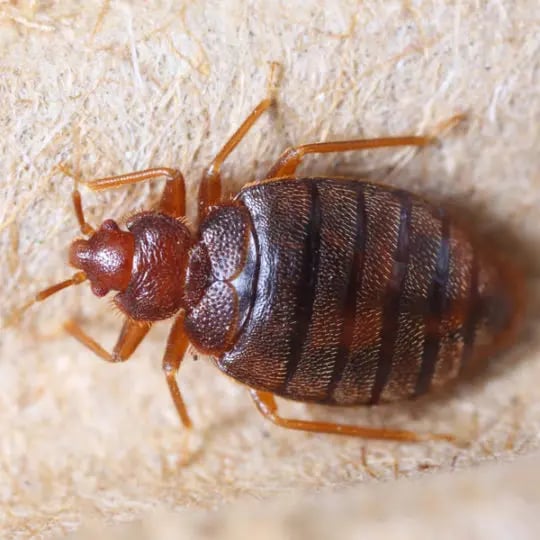Experienced DC Exterminator for Bed Bug Heat Treatment Near Me
Experienced DC Exterminator for Bed Bug Heat Treatment Near Me
Blog Article
Exploring the Scientific Research Behind Bed Bug Warmth Treatments as a Sustainable Parasite Administration Strategy
One such technique that has obtained grip in current years is the usage of heat therapies to combat bed insect invasions. The complexities of exactly how warm properly eliminates bed insects and the wider effects for lasting parasite management practices make this a topic worth checking out additionally.
Bed Pest Warmth Therapy Refine

Thermal Death Factor for Bed Insects
Exposing bed insects to elevated temperature levels beyond their thermal resistance variety is critical for achieving efficient eradication in warmth treatment processes. The thermal death factor for bed bugs describes the temperature level at which these pests can not survive. Research study suggests that bed pests start to die when exposed to temperature levels above 113 ° F(45 ° C) for a continual period. As the temperature enhances, so does the mortality rate of bed pests. At around 118 ° F(48 ° C ), bed bugs start to pass away quickly, with a death price of almost 99% within minutes of exposure. This shows the level of sensitivity of bed insects to heats and highlights the effectiveness of warm treatments in removing infestations. By reaching and preserving temperature levels above the thermal death factor for bed pests, insect monitoring professionals can guarantee detailed removal of bed bug populations, including hard-to-reach locations where chemical treatments may be less efficient. Recognizing the thermal fatality factor for bed bugs is vital for applying successful heat treatment methods and attaining lasting parasite management results.
Benefits of Warm Treatments
Having established the crucial thermal death factor for bed pests, it is vital to now discover the substantial advantages that heat therapies use in successfully removing these durable pests. When contrasted to typical chemical techniques, heat therapies existing go to website a number of essential advantages. One of the primary benefits is that heat can pass through deep into cracks and holes where bed bugs conceal, guaranteeing that also the most hard-to-reach areas are warmed to lethal temperature levels. This extensive approach not only eliminates live pests yet likewise targets bed bug eggs, protecting against future invasions.
Additionally, warm therapies are ecologically friendly and non-toxic, making them a sustainable bug monitoring method. Unlike chemical pesticides, warmth therapies do not leave dangerous deposits that can present threats to human health and wellness or the environment. This aspect is especially crucial in delicate atmospheres such as health centers, institutions, and houses where chemical usage might not be preferable.
In addition, warmth therapies have a high success price in removing bed pest problems in a solitary therapy, minimizing the demand for numerous brows through and decreasing interruption to passengers. This effectiveness not only saves money and time but also provides tranquility of mind to those managing bed pest issues.
Efficiency of Warm Treatment

Heat treatments have actually the included advantage of killing bed pest eggs, which are frequently resistant to standard chemical therapies. Overall, the efficiency of warm therapies in getting rid of bed pest infestations makes them a lasting and trusted pest administration method.
Lasting Bug Management Perks
Applying lasting parasite monitoring methods offers long-term benefits for both the setting and public wellness. By using techniques such as heat treatments for parasite control, we can lower the dependence on unsafe chemical pesticides that can have damaging results on ecological communities and human health and wellness - bed bug heat treatment. Sustainable insect monitoring approaches assist in protecting biodiversity by targeting certain insects without harming non-target microorganisms, thus maintaining a well balanced community
Additionally, lasting parasite administration practices add to the general wellness and wellness of the public. By lessening exposure to poisonous chemicals utilized in conventional parasite control techniques, warmth treatments give a much safer choice for bug management in property, navigate to these guys industrial, and public spaces. This reduction in chemical use also aids in avoiding chemical residues from polluting best site dirt, air, and water, securing ecological high quality.
Verdict
Finally, bed insect heat therapies have actually been shown to be a lasting and effective bug monitoring strategy. The thermal death factor for bed pests makes them at risk to warm therapies, which have numerous advantages over typical chemical treatments. The effectiveness of warm treatments in removing bed pest infestations while lessening ecological influence highlights the potential of this method as a sustainable service for bug control.
The bed pest warm therapy procedure involves raising the temperature within plagued areas to a level that efficiently removes bed pests and their eggs. By getting to and keeping temperature levels over the thermal fatality factor for bed pests, parasite monitoring professionals can guarantee extensive elimination of bed bug populations, including hard-to-reach areas where chemical treatments might be much less reliable. One of the key benefits is that warm can permeate deep into crevices and cracks where bed bugs conceal, ensuring that even the most hard-to-reach locations are warmed to dangerous temperature levels. Unlike chemical treatments that may leave behind immune populaces, warm therapies use a non-toxic and environmentally pleasant solution that can pass through deep right into furniture, wall surfaces, and various other hard-to-reach areas where bed bugs conceal.
The thermal fatality point for bed pests makes them at risk to warm treatments, which have numerous benefits over traditional chemical treatments.
Report this page